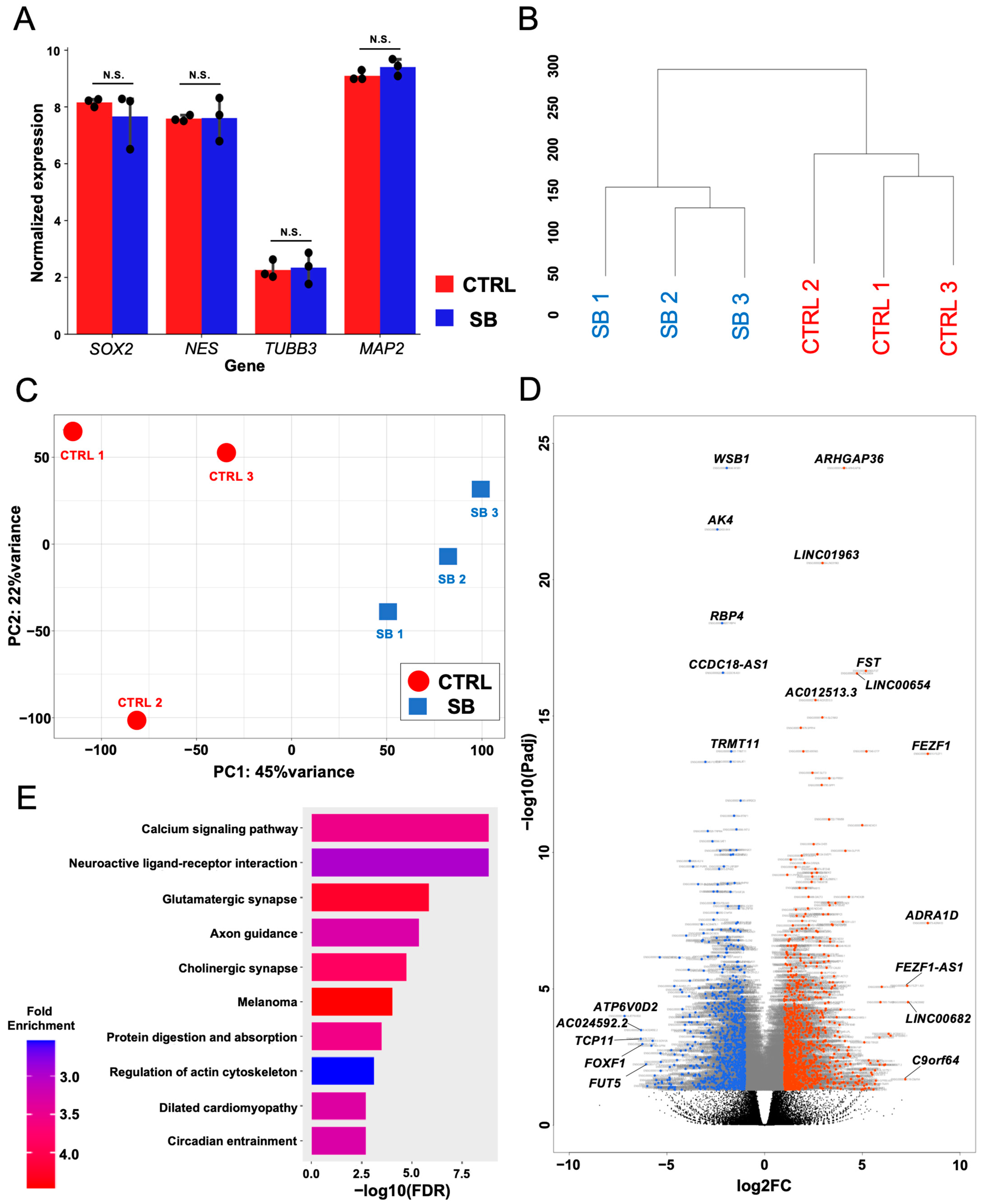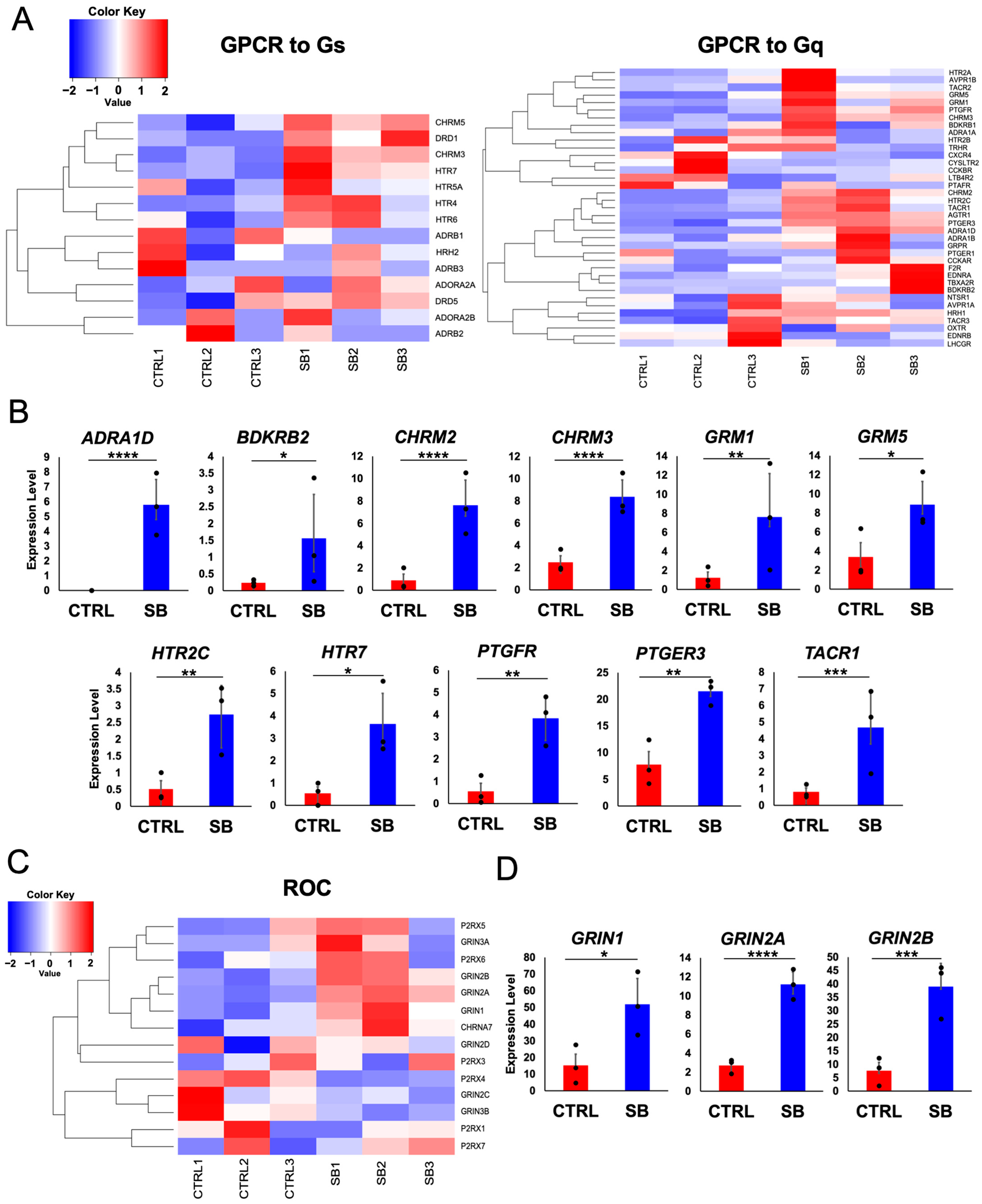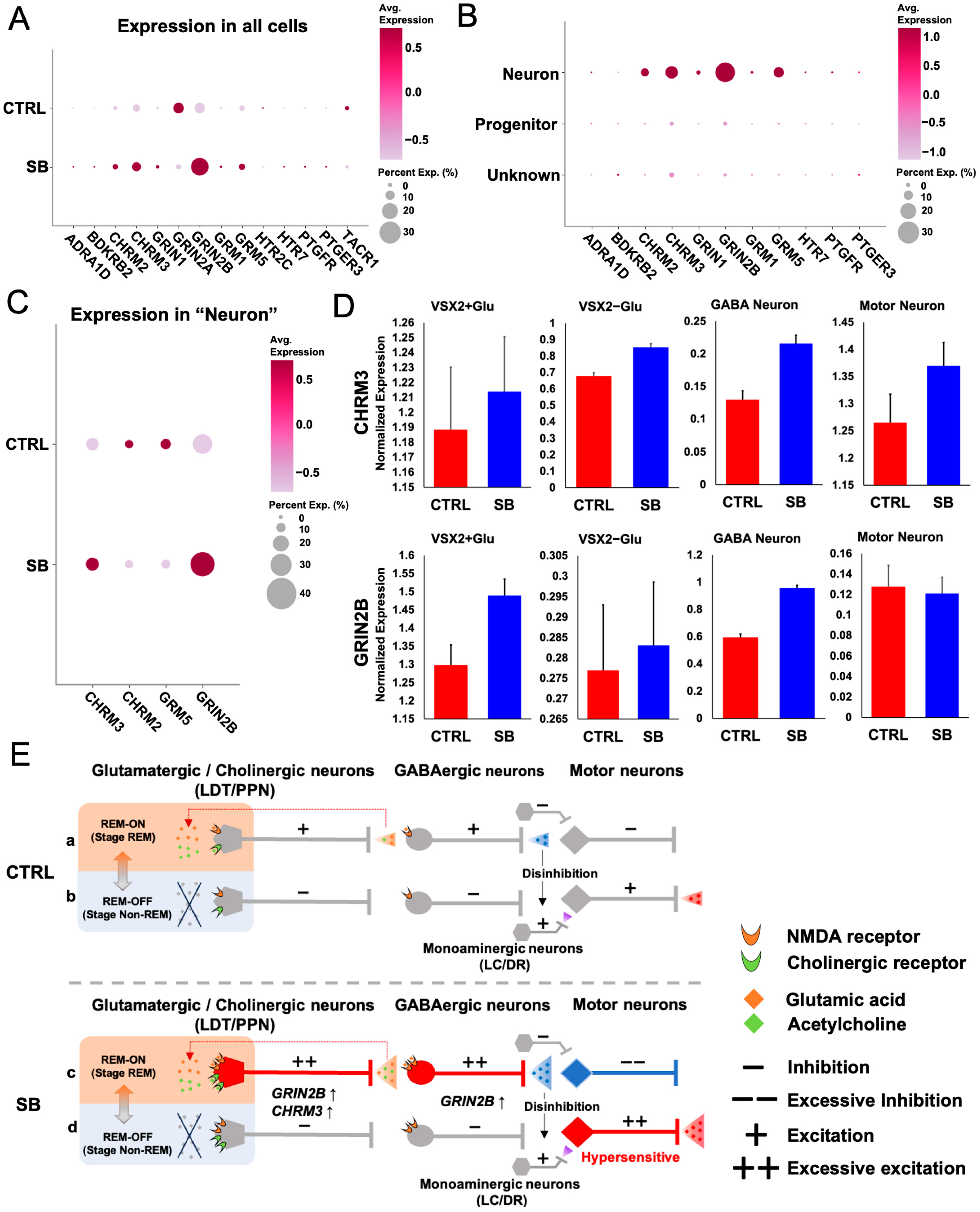Comprehensive Gene Expression Analysis Using Human Induced Pluripotent Stem Cells Derived from Patients with Sleep Bruxism: A Preliminary In Vitro Study
Abstract
1. Introduction
2. Results
2.1. Polarization of Gene Expression Patterns in Control and SB Samples
2.2. SB Patient-Specific Gene Expression Profiles of Calcium Signaling Pathways
2.3. Analysis of Neuronal Subtype Marker Genes and Identification of Genes Related to the Laterodorsal Tegmental Nucleus
2.4. Comparison of GRIN2B and CHRM3 Expression Between Neuronal Subtypes in Patients with SB
3. Discussion
3.1. Calcium Signaling Dysregulation as a Potential Mechanism for Neuronal Activity Imbalance in SB
3.2. GRIN2B and CHRM3 Overexpression as Drivers of Neuronal Hyperexcitability in SB
3.3. Impact of SNP rs6313 on GRIN2B and CHRM3 Expression in SB Neurons
3.4. Hypothesis on the Mechanisms Underlying SB-Related Muscle Activity
3.5. Limitations
4. Materials and Methods
4.1. Ethics Statement
4.2. iPSC Culture
4.3. Neuronal Differentiation
4.4. Bulk RNA-Seq
4.5. Single-Nucleus RNA-Seq
4.6. Statistical Analysis
5. Conclusions
Supplementary Materials
Author Contributions
Funding
Institutional Review Board Statement
Informed Consent Statement
Data Availability Statement
Acknowledgments
Conflicts of Interest
References
- Sateia, M.J. International classification of sleep disorders-third edition highlights and modifications. Chest 2014, 146, 1387–1394. [Google Scholar] [CrossRef] [PubMed]
- Beddis, H.; Pemberton, M.; Davies, S. Sleep bruxism: An overview for clinicians. Br. Dent. J. 2018, 225, 497–501. [Google Scholar] [CrossRef] [PubMed]
- Čalić, A.; Peterlin, B. Epigenetics and bruxism: Possible role of epigenetics in the etiology of bruxism. Int. J. Prosthodont. 2015, 28, 594–599. [Google Scholar] [CrossRef] [PubMed]
- Rintakoski, K.; Hublin, C.; Lobbezoo, F.; Rose, R.J.; Kaprio, J. Genetic factors account for half of the phenotypic variance in liability to sleep-related bruxism in young adults: A nationwide Finnish twin cohort study. Twin Res. Hum. Genet. 2012, 15, 714–719. [Google Scholar] [CrossRef]
- Hublin, C.; Kaprio, J.; Partinen, M.; Koskenvuo, M. Sleep bruxism based on self-report in a nationwide twin cohort. J. Sleep Res. 1998, 7, 61–67. [Google Scholar] [CrossRef]
- Shetty, S.; Pitti, V.; Satish Babu, C.L.; Surendra Kumar, G.P.; Deepthi, B.C. Bruxism: A literature review. J. Indian Prosthodont. Soc. 2010, 10, 141–148. [Google Scholar] [CrossRef]
- Lavigne, G.J.; Khoury, S.; Abe, S.; Yamaguchi, T.; Raphael, K. Bruxism physiology and pathology: An overview for clinicians. J. Oral Rehabil. 2008, 35, 476–494. [Google Scholar] [CrossRef]
- Kato, T.; Montplaisir, J.Y.; Guitard, F.; Sessle, B.J.; Lund, J.P.; Lavigne, G.J. Evidence that experimentally induced sleep bruxism is a consequence of transient arousal. J. Dent. Res. 2003, 82, 284–288. [Google Scholar] [CrossRef]
- Kato, T.; Higashiyama, M.; Katagiri, A.; Toyoda, H.; Yamada, M.; Minota, N.; Katsura-Fuchihata, S.; Zhu, Y. Understanding the pathophysiology of sleep bruxism based on human and animal studies: A narrative review. J. Oral Biosci. 2023, 65, 156–162. [Google Scholar] [CrossRef]
- Lavigne, G.J.; Kato, T.; Kolta, A.; Sessle, B.J. Neurobiological mechanisms involved in sleep bruxism. Crit. Rev. Oral Biol. Med. 2003, 14, 30–46. [Google Scholar] [CrossRef]
- Toossi, H.; Del Cid-Pellitero, E.; Jones, B.E. Homeostatic regulation through GABA and acetylcholine muscarinic receptors of motor trigeminal neurons following sleep deprivation. Brain Struct. Funct. 2017, 222, 3163–3178. [Google Scholar] [CrossRef] [PubMed]
- Halász, P.; Terzano, M.; Parrino, L.; Bódizs, R. The nature of arousal in sleep. J. Sleep Res. 2004, 13, 1–23. [Google Scholar] [CrossRef] [PubMed]
- Kato, T.; Rompré, P.; Montplaisir, J.Y.; Sessle, B.J.; Lavigne, G.J. Sleep bruxism: An oromotor activity secondary to micro-arousal. J. Dent. Res. 2001, 80, 1940–1944. [Google Scholar] [CrossRef] [PubMed]
- Huynh, N.; Kato, T.; Rompré, P.H.; Okura, K.; Saber, M.; Lanfranchi, P.A.; Montplaisir, J.Y.; Lavigne, G.J. Sleep bruxism is associated to micro-arousals and an increase in cardiac sympathetic activity. J. Sleep Res. 2006, 15, 339–346. [Google Scholar] [CrossRef]
- Fan, X.; Qu, F.; Wang, J.J.; Du, X.; Liu, W.C. Decreased γ-aminobutyric acid levels in the brainstem in patients with possible sleep bruxism: A pilot study. J. Oral Rehabil. 2017, 44, 934–940. [Google Scholar] [CrossRef]
- Giovanni, A.; Giorgia, A. The neurophysiological basis of bruxism. Heliyon 2021, 7, e07477. [Google Scholar] [CrossRef]
- Dubé, C.; Rompré, P.H.; Manzini, C.; Guitard, F.; de Grandmont, P.; Lavigne, G.J. Quantitative polygraphic controlled study on efficacy and safety of oral splint devices in tooth-grinding subjects. J. Dent. Res. 2004, 83, 398–403. [Google Scholar] [CrossRef]
- Abe, Y.; Suganuma, T.; Ishii, M.; Yamamoto, G.; Gunji, T.; Clark, G.T.; Tachikawa, T.; Kiuchi, Y.; Igarashi, Y.; Baba, K. Association of genetic, psychological and behavioral factors with sleep bruxism in a Japanese population. J. Sleep Res. 2012, 21, 289–296. [Google Scholar] [CrossRef]
- Hoashi, Y.; Okamoto, S.; Abe, Y.; Matsumoto, T.; Tanaka, J.; Yoshida, Y.; Imaizumi, K.; Mishima, K.; Akamatsu, W.; Okano, H.; et al. Generation of neural cells using IPSCs from sleep bruxism patients with 5-HT2A polymorphism. J. Prosthodont. Res. 2017, 61, 242–250. [Google Scholar] [CrossRef]
- Sarkar, A.K.; Nakamura, S.; Nakai, K.; Sato, T.; Shiga, T.; Abe, Y.; Hoashi, Y.; Inoue, T.; Akamatsu, W.; Baba, K. Increased excitability of human iPSC-derived neurons in HTR2A variant-related sleep bruxism. Stem Cell Res. 2022, 59, 102658. [Google Scholar] [CrossRef]
- Md Rahman, M.M.M.; Mim, S.A.; Md Islam, R.; Sultana, N.; Ahmed, M.; Kamal, M.A. Role of G-proteins and GPCR-mediated signalling in neuropathophysiology. CNS Neurol. Disord. Drug Targets 2022, 22, 2–5. [Google Scholar] [CrossRef]
- Zhou, A.; Liu, X.; Yu, P. Bifurcation analysis on the effect of store-operated and receptor-operated calcium channels for calcium oscillations in astrocytes. Nonlinear Dyn. 2019, 97, 733–748. [Google Scholar] [CrossRef]
- Jerber, J.; Seaton, D.D.; Cuomo, A.S.E.; Kumasaka, N.; Haldane, J.; Steer, J.; Patel, M.; Pearce, D.; Andersson, M.; Bonder, M.J.; et al. Population-scale single-cell RNA-seq profiling across dopaminergic neuron differentiation. Nat. Genet. 2021, 53, 304–312. [Google Scholar] [CrossRef] [PubMed]
- Lui, K.N.C.; Li, Z.; Lai, F.P.L.; Lau, S.T.; Ngan, E.S.W. Organoid models of breathing disorders reveal patterning defect of hindbrain neurons caused by PHOX2B-PARMs. Stem Cell Rep. 2023, 18, 1500–1515. [Google Scholar] [CrossRef]
- Morello, F.; Borshagovski, D.; Survila, M.; Tikker, L.; Sadik-Ogli, S.; Kirjavainen, A.; Estartús, N.; Knaapi, L.; Lahti, L.; Törönen, P.; et al. Molecular fingerprint and developmental regulation of the tegmental GABAergic and glutamatergic neurons derived from the anterior hindbrain. Cell Rep. 2020, 33, 108268. [Google Scholar] [CrossRef]
- Goñi-Erro, H.; Selvan, R.; Caggiano, V.; Leiras, R.; Kiehn, O. Pedunculopontine Chx10+ neurons control global motor arrest in mice. Nat. Neurosci. 2023, 26, 1516–1528. [Google Scholar] [CrossRef]
- Peever, J.; Fuller, P.M. The biology of REM sleep. Curr. Biol. 2017, 27, R1237–R1248. [Google Scholar] [CrossRef]
- Berridge, M.J. Neuronal calcium signaling. Neuron 1998, 21, 13–26. [Google Scholar] [CrossRef]
- Brini, M.; Calì, T.; Ottolini, D.; Carafoli, E. Neuronal calcium signaling: Function and dysfunction. Cell. Mol. Life Sci. 2014, 71, 2787–2814. [Google Scholar] [CrossRef]
- Mueller, B.D.; Merrill, S.A.; Watanabe, S.; Liu, P.; Niu, L.; Singh, A.; Maldonado-Catala, P.; Cherry, A.; Rich, M.S.; Silva, M.; et al. CaV1 and CaV2 calcium channels mediate the release of distinct pools of synaptic vesicles. eLife 2023, 12, e81407. [Google Scholar] [CrossRef]
- Steinlein, O.K. Calcium signaling and epilepsy. Cell Tissue Res. 2014, 357, 385–393. [Google Scholar] [CrossRef] [PubMed]
- Ban, H.-J.; Kim, S.C.; Seo, J.; Kang, H.-B.; Choi, J.K. Genetic and metabolic characterization of insomnia. PLoS ONE 2011, 6, e18455. [Google Scholar] [CrossRef] [PubMed]
- Paoletti, P.; Bellone, C.; Zhou, Q. NMDA receptor subunit diversity: Impact on receptor properties, synaptic plasticity and disease. Nat. Rev. Neurosci. 2013, 14, 383–400. [Google Scholar] [CrossRef] [PubMed]
- Endele, S.; Rosenberger, G.; Geider, K.; Popp, B.; Tamer, C.; Stefanova, I.; Milh, M.; Kortüm, F.; Fritsch, A.; Pientka, F.K.; et al. Mutations in GRIN2A and GRIN2B encoding regulatory subunits of NMDA receptors cause variable neurodevelopmental phenotypes. Nat. Genet. 2010, 42, 1021–1026. [Google Scholar] [CrossRef]
- Yuan, H.; Hansen, K.B.; Zhang, J.; Pierson, T.M.; Markello, T.C.; Fajardo, K.V.F.; Holloman, C.M.; Golas, G.; Adams, D.R.; Boerkoel, C.F.; et al. Functional analysis of a de novo GRIN2A missense mutation associated with early-onset epileptic encephalopathy. Nat. Commun. 2014, 5, 3251. [Google Scholar] [CrossRef]
- Candelas Serra, M.; Kuchtiak, V.; Kubik-Zahorodna, A.; Kysilov, B.; Fili, K.; Hrcka Krausova, B.; Abramova, V.; Dobrovolski, M.; Harant, K.; Bozikova, P.; et al. Characterization of mice carrying a neurodevelopmental disease-associated GluN2B(L825V) variant. J. Neurosci. 2024, 44, e2291232024. [Google Scholar] [CrossRef]
- Leung, A.K.C.; Wong, A.H.C.; Lam, J.; Hon, K.L. Sleep bruxism in children: A narrative review. Curr. Pediatr. Rev. 2023, 20, 40–50. [Google Scholar] [CrossRef]
- Goddard, R.J.; Krijnen, W.P.; Roelfsema, V.; Waninge, A.; Driessen, J.M.M. The prevalence of bruxism in children with profound intellectual and multiple disabilities; a systematic review and meta-analysis. Brain Disord. 2024, 15, 100131. [Google Scholar] [CrossRef]
- Wess, J. Molecular biology of muscarinic acetylcholine receptors. Crit. Rev. Neurobiol. 1996, 10, 69–99. [Google Scholar] [CrossRef]
- Ishii, M.; Kurachi, Y. Muscarinic acetylcholine receptors. Curr. Pharm. Des. 2006, 12, 3573–3581. [Google Scholar] [CrossRef]
- Niwa, Y.; Kanda, G.N.; Yamada, R.G.; Shi, S.; Sunagawa, G.A.; Ukai-Tadenuma, M.; Fujishima, H.; Matsumoto, N.; Masumoto, K.; Hei, N.; et al. Muscarinic acetylcholine receptors Chrm1 and Chrm3 are essential for REM sleep. Cell Rep. 2018, 24, 2231–2247.e7. [Google Scholar] [CrossRef] [PubMed]
- Wang, Y.; Tan, X.; Chen, Z.; Zhang, B.; Gao, Y.; Wang, Y. Association between the Rs6313 polymorphism in the 5-HTR2A gene and the efficacy of antipsychotic drugs. BMC Psychiatry 2023, 23, 682. [Google Scholar] [CrossRef] [PubMed]
- Zabotina, A.M.; Belinskaya, M.A.; Zhuravlev, A.S.; Nasyrova, R.F.; Sosin, D.N.; Ershov, E.E.; Taraskina, A.E.; Krupitsky, E.M. The Influence of Rs6311 and Rs6313 Polymorphisms of serotonin 2A Receptor Gene (HTR2A) on Its mRNA and Protein Levels in peripheral Blood leukocytes in Treatment with Antipsychotics. Cell Tissue Biol. 2018, 12, 382–390. [Google Scholar] [CrossRef]
- Dantsuji, M.; Nakamura, S.; Nakayama, K.; Mochizuki, A.; Park, S.K.; Bae, Y.C.; Ozeki, M.; Inoue, T. 5-HT2A receptor activation enhances NMDA receptor-mediated glutamate responses through Src kinase in the dendrites of rat jaw-closing motoneurons. J. Physiol. 2019, 597, 2565–2589. [Google Scholar] [CrossRef] [PubMed]
- España, R.A.; Scammell, T.E. Sleep neurobiology from a clinical perspective. Sleep 2011, 34, 845–858. [Google Scholar] [CrossRef] [PubMed]
- Wang, X.; Yang, H.; Pan, L.; Hao, S.; Wu, X.; Zhan, L.; Liu, Y.; Meng, F.; Lou, H.; Shen, Y.; et al. Brain-wide mapping of mono-synaptic afferents to different cell types in the laterodorsal tegmentum. Neurosci. Bull. 2019, 35, 781–790. [Google Scholar] [CrossRef]
- Baldini, T.; Loddo, G.; Ferri, R.; Provini, F. Neurobiology of parasomnias. In Sleep Neurology; Springer International Publishing: Cham, Switzerland, 2021; pp. 121–145. [Google Scholar]
- Rukhadze, I.; Kamani, H.; Kubin, L. Quantitative differences among EMG activities of muscles innervated by subpopulations of hypoglossal and upper spinal motoneurons during non-REM sleep—REM sleep transitions: A window on neural processes in the sleeping brain. Arch. Ital. Biol. 2011, 149, 499–515. [Google Scholar] [CrossRef]
- Allena, M.; Campus, C.; Morrone, E.; De Carli, F.; Garbarino, S.; Manfredi, C.; Sebastiano, D.R.; Ferrillo, F. Periodic limb movements both in non-REM and REM sleep: Relationships between cerebral and autonomic activities. Clin. Neurophysiol. 2009, 120, 1282–1290. [Google Scholar] [CrossRef]
- Saper, C.B.; Fuller, P.M.; Pedersen, N.P.; Lu, J.; Scammell, T.E. Sleep state switching. Neuron 2010, 68, 1023–1042. [Google Scholar] [CrossRef]
- Zhu, T.; Wei, S.; Wang, Y. Post-inhibitory rebound firing of dorsal root ganglia neurons. J. Pain Res. 2022, 15, 2029–2040. [Google Scholar] [CrossRef]
- Perrier, J.-F.; Rasmussen, H.B.; Christensen, R.K.; Petersen, A.V. Modulation of the intrinsic properties of motoneurons by serotonin. Curr. Pharm. Des. 2013, 19, 4371–4384. [Google Scholar] [CrossRef] [PubMed]
- Samuels, E.R.; Szabadi, E. Functional neuroanatomy of the noradrenergic locus coeruleus: Its roles in the regulation of arousal and autonomic function Part I: Principles of functional organisation. Curr. Neuropharmacol. 2008, 6, 235–253. [Google Scholar] [CrossRef] [PubMed]
- Gugel, A.; Ingebretsen, E.A.; Hake, H.S.; Gantz, S.C. LC-derived excitatory synaptic transmission to dorsal raphe serotonin neurons is inhibited by activation of Alpha2-adrenergic receptors. Neuropsychopharmacology 2024, 49, 1014–1023. [Google Scholar] [CrossRef]
- Saletu, A.; Parapatics, S.; Anderer, P.; Matejka, M.; Saletu, B. Controlled clinical, polysomnographic and psychometric studies on differences between sleep bruxers and controls and acute effects of clonazepam as compared with placebo. Eur. Arch. Psychiatry Clin. Neurosci. 2010, 260, 163–174. [Google Scholar] [CrossRef]
- Ishikawa, I.; Shinno, H.; Ando, N.; Mori, T.; Nakamura, Y. The effect of memantine on sleep architecture and psychiatric symptoms in patients with Alzheimer’s disease. Acta Neuropsychiatr. 2016, 28, 157–164. [Google Scholar] [CrossRef]
- Fujimori, K.; Matsumoto, T.; Kisa, F.; Hattori, N.; Okano, H.; Akamatsu, W. Escape from pluripotency via inhibition of TGF-β/BMP and activation of Wnt signaling accelerates differentiation and aging in HPSC progeny cells. Stem Cell Rep. 2017, 9, 1675–1691. [Google Scholar] [CrossRef]
- Kim, D.; Langmead, B.; Salzberg, S.L. HISAT: A fast spliced aligner with low memory requirements. Nat. Methods 2015, 12, 357–360. [Google Scholar] [CrossRef]
- Li, H.; Handsaker, B.; Wysoker, A.; Fennell, T.; Ruan, J.; Homer, N.; Marth, G.; Abecasis, G.; Durbin, R.; 1000 Genome Project Data Processing Subgroup. The sequence alignment/map format and SAMtools. Bioinformatics 2009, 25, 2078–2079. [Google Scholar] [CrossRef]
- Liao, Y.; Smyth, G.K.; Shi, W. FeatureCounts: An efficient general purpose program for assigning sequence reads to genomic features. Bioinformatics 2014, 30, 923–930. [Google Scholar] [CrossRef]
- Wu, T.; Hu, E.; Xu, S.; Chen, M.; Guo, P.; Dai, Z.; Feng, T.; Zhou, L.; Tang, W.; Zhan, L.; et al. ClusterProfiler 4.0: A universal enrichment tool for interpreting omics data. Innovation 2021, 2, 100141. [Google Scholar] [CrossRef]
- Rompré, P.H.; Daigle-Landry, D.; Guitard, F.; Montplaisir, J.Y.; Lavigne, G.J. Identification of a sleep bruxism subgroup with a higher risk of pain. J. Dent. Res. 2007, 86, 837–842. [Google Scholar] [CrossRef] [PubMed]




Disclaimer/Publisher’s Note: The statements, opinions and data contained in all publications are solely those of the individual author(s) and contributor(s) and not of MDPI and/or the editor(s). MDPI and/or the editor(s) disclaim responsibility for any injury to people or property resulting from any ideas, methods, instructions or products referred to in the content. |
© 2024 by the authors. Licensee MDPI, Basel, Switzerland. This article is an open access article distributed under the terms and conditions of the Creative Commons Attribution (CC BY) license (https://creativecommons.org/licenses/by/4.0/).
Share and Cite
Sato, T.; Yamaguchi, A.; Onishi, M.; Abe, Y.; Shiga, T.; Ishikawa, K.-i.; Baba, K.; Akamatsu, W. Comprehensive Gene Expression Analysis Using Human Induced Pluripotent Stem Cells Derived from Patients with Sleep Bruxism: A Preliminary In Vitro Study. Int. J. Mol. Sci. 2024, 25, 13141. https://doi.org/10.3390/ijms252313141
Sato T, Yamaguchi A, Onishi M, Abe Y, Shiga T, Ishikawa K-i, Baba K, Akamatsu W. Comprehensive Gene Expression Analysis Using Human Induced Pluripotent Stem Cells Derived from Patients with Sleep Bruxism: A Preliminary In Vitro Study. International Journal of Molecular Sciences. 2024; 25(23):13141. https://doi.org/10.3390/ijms252313141
Chicago/Turabian StyleSato, Taro, Akihiro Yamaguchi, Mayu Onishi, Yuka Abe, Takahiro Shiga, Kei-ichi Ishikawa, Kazuyoshi Baba, and Wado Akamatsu. 2024. "Comprehensive Gene Expression Analysis Using Human Induced Pluripotent Stem Cells Derived from Patients with Sleep Bruxism: A Preliminary In Vitro Study" International Journal of Molecular Sciences 25, no. 23: 13141. https://doi.org/10.3390/ijms252313141
APA StyleSato, T., Yamaguchi, A., Onishi, M., Abe, Y., Shiga, T., Ishikawa, K.-i., Baba, K., & Akamatsu, W. (2024). Comprehensive Gene Expression Analysis Using Human Induced Pluripotent Stem Cells Derived from Patients with Sleep Bruxism: A Preliminary In Vitro Study. International Journal of Molecular Sciences, 25(23), 13141. https://doi.org/10.3390/ijms252313141






